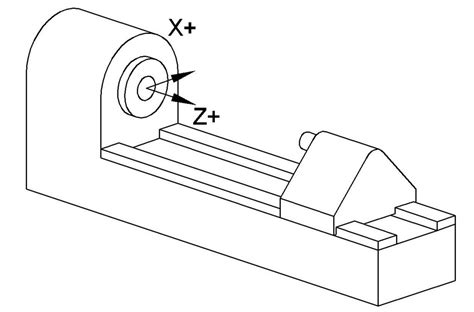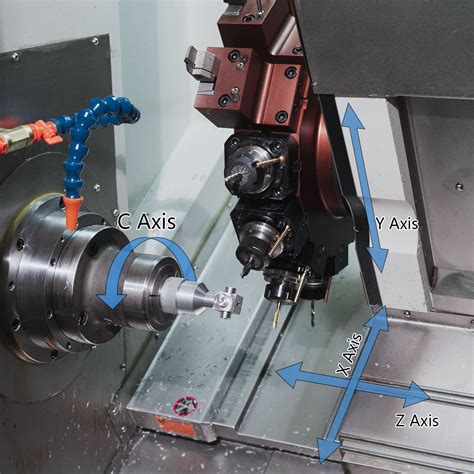cnc lathe machine axis In this article, we discuss linear and rotary axes, concepts that introduce us to the different CNC machine axis configurations in various systems. We will explore the various . $99.14
0 · machining lathe axis diagram
1 · lathe axis explained
2 · cnc mill axis diagram
3 · cnc machine axis locations diagram
4 · cnc lathe axis explained
5 · cnc lathe axis directions
6 · cnc axis chart
7 · axis identification in cnc machine
$62.95
The Z axis is parallel to the axis on the workpiece, allowing the tool to move along the side of the material as the part rotates about the Z axis (C). The movement along the Z axis determines the length of the job. See moreThe X axis is perpendicular to the Z axis, allowing the tool to move back and forth along the X axis to determine the diameter of the part. See moreThe C axis is defined as the rotary table in the center of the workbench, which rotates 360 degrees around the Z axis. The front end of the shaft is a rotary head that can also rotate 360 degrees around the Z axis, becoming the C axis. Related reading: 4-Axis and 5-Axis CNC . See more1. Rotary motion: The rotary motion around the X, Y and Z axes is represented by A, B and C respectively, and the positive direction is determined according to the right-hand . See more

In this article, we discuss linear and rotary axes, concepts that introduce us to the different CNC machine axis configurations in various systems. We will explore the various . This comprehensive guide explains the different axes on a CNC lathe, including the X, Y, and Z axes, and how they work together to control the movements of the cutting tool. Understanding these axes is essential for .If you’re wondering how many axis in cnc lathe machine, here’s a quick overview: 2-axis: Basic turning operations. 3-axis: Adds live tooling for milling, drilling, and tapping.In this comprehensive guide to CNC machine axes, we have explored the fundamentals of each axis, their functions, and applications in the realm of CNC machining. By understanding the .
CNC Lathe machines with 6 or more axes represent the pinnacle of machining flexibility and precision. These lathes can manipulate the workpiece and the tool in multiple directions simultaneously, offering unparalleled . Elementary CNC lathes employ a binary-axis system (incorporating the X and Z-axis), mirroring their more conventional counterparts. These machines excel at automating routine lathe operations while enhancing . Using an X, Y or Z code in a CNC program tells the machine to go to a specific location along those axes. Location changes can be in one or more axes. If only a Z axis coordinate is given then the machine will only move in .CNC machining is the process of removing material from a workpiece until the desired shape is configured. These machines have at least a 3 axes and operate along an XYZ plane: X axis (vertical), Y axis (horizontal), and a Z axis (depth).
machining lathe axis diagram
Explore our range of CNC Lathe Machines & Turning Centres. The different types of CNC lathe can be determined by the number of movement axes: 2-axis – can perform outer/inner diameter machining, facing, drilling, and tapping. 4-axis – .
Typically, CNC lathes come with 2 axes as standard, while CNC milling machines come with 3 axes as standard. However, the number of axes in a CNC system can vary, with some lathes capable of 6-axis linkage or even controlling more than 10 axes. The exact number of axes is determined by the system’s function. How many CNC lathes are there? In this article, we discuss linear and rotary axes, concepts that introduce us to the different CNC machine axis configurations in various systems. We will explore the various types of CNC machines based on the number of axes they have, ultimately covering whether systems with more CNC machine axis counts are better.
This comprehensive guide explains the different axes on a CNC lathe, including the X, Y, and Z axes, and how they work together to control the movements of the cutting tool. Understanding these axes is essential for anyone operating a CNC lathe. Learn more here.If you’re wondering how many axis in cnc lathe machine, here’s a quick overview: 2-axis: Basic turning operations. 3-axis: Adds live tooling for milling, drilling, and tapping.In this comprehensive guide to CNC machine axes, we have explored the fundamentals of each axis, their functions, and applications in the realm of CNC machining. By understanding the role and significance of the X, Y, Z, and additional axes, as well as the potential of multi-axis and specialized machines, you now possess the knowledge necessary . CNC Lathe machines with 6 or more axes represent the pinnacle of machining flexibility and precision. These lathes can manipulate the workpiece and the tool in multiple directions simultaneously, offering unparalleled capability in creating highly complex parts.
lathe axis explained
Elementary CNC lathes employ a binary-axis system (incorporating the X and Z-axis), mirroring their more conventional counterparts. These machines excel at automating routine lathe operations while enhancing precision and consistency.
Using an X, Y or Z code in a CNC program tells the machine to go to a specific location along those axes. Location changes can be in one or more axes. If only a Z axis coordinate is given then the machine will only move in the Z axis. This is .CNC machining is the process of removing material from a workpiece until the desired shape is configured. These machines have at least a 3 axes and operate along an XYZ plane: X axis (vertical), Y axis (horizontal), and a Z axis (depth).
sheet metal union san francisco
Explore our range of CNC Lathe Machines & Turning Centres. The different types of CNC lathe can be determined by the number of movement axes: 2-axis – can perform outer/inner diameter machining, facing, drilling, and tapping. 4-axis – typically adds a second tool carrier or turret. Typically, CNC lathes come with 2 axes as standard, while CNC milling machines come with 3 axes as standard. However, the number of axes in a CNC system can vary, with some lathes capable of 6-axis linkage or even controlling more than 10 axes. The exact number of axes is determined by the system’s function. How many CNC lathes are there?
In this article, we discuss linear and rotary axes, concepts that introduce us to the different CNC machine axis configurations in various systems. We will explore the various types of CNC machines based on the number of axes they have, ultimately covering whether systems with more CNC machine axis counts are better. This comprehensive guide explains the different axes on a CNC lathe, including the X, Y, and Z axes, and how they work together to control the movements of the cutting tool. Understanding these axes is essential for anyone operating a CNC lathe. Learn more here.If you’re wondering how many axis in cnc lathe machine, here’s a quick overview: 2-axis: Basic turning operations. 3-axis: Adds live tooling for milling, drilling, and tapping.
In this comprehensive guide to CNC machine axes, we have explored the fundamentals of each axis, their functions, and applications in the realm of CNC machining. By understanding the role and significance of the X, Y, Z, and additional axes, as well as the potential of multi-axis and specialized machines, you now possess the knowledge necessary . CNC Lathe machines with 6 or more axes represent the pinnacle of machining flexibility and precision. These lathes can manipulate the workpiece and the tool in multiple directions simultaneously, offering unparalleled capability in creating highly complex parts. Elementary CNC lathes employ a binary-axis system (incorporating the X and Z-axis), mirroring their more conventional counterparts. These machines excel at automating routine lathe operations while enhancing precision and consistency.
cnc mill axis diagram
Using an X, Y or Z code in a CNC program tells the machine to go to a specific location along those axes. Location changes can be in one or more axes. If only a Z axis coordinate is given then the machine will only move in the Z axis. This is .CNC machining is the process of removing material from a workpiece until the desired shape is configured. These machines have at least a 3 axes and operate along an XYZ plane: X axis (vertical), Y axis (horizontal), and a Z axis (depth).
cnc machine axis locations diagram
cnc lathe axis explained
cnc lathe axis directions

Shop our vintage metal file cabinets selection from top sellers and makers around the world. Global shipping available.
cnc lathe machine axis|cnc machine axis locations diagram